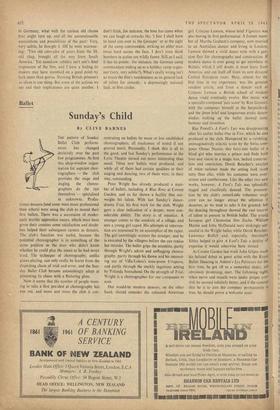Ballet
Sunday's Child
By CLIVE BARNES THE pattern of Sunday Ballet Club perform- ances has changed decisively over the past few programmes. At first this shop-window organ- isation for aspirant chor- eographers — the club provides the stage and staging, the choreo- graphers do the rest themselves — specialised in unknowns. Profes- sional dancers (and some were more professional than others) were using the club to mount their first ballets. There was a succession of moder- ately worthy apprentice essays, which must have given their creators some satisfaction and doubt- less helped their subsequent careers as dancers. The club's function was useful, because the potential choreographer is in something of the same position as the man who didn't know whether he could play the piano as he had never tried. The technique of choreography, unlike piano-playing, can only really be learnt from the dispiriting chaos of trial and error, and the Sun- day Ballet Club became astonishingly adept at presenting its chaos with a flattering gloss.
Now it seems that the number of people want- ing to take a first pot-shot at choreography has un out, and more and more the club is con- centrating on ballets by more or less established choreographers, all marksmen of tested if not proved merit. Personally, I think this is all to the good, and last Sunday's performance at the Lyric Theatre turned out more interesting than usual. Three new ballets were produced, and while all of them had certain qualities in their staging and dancing, two of them were, in their way, outstanding.
Peter Wright has already produced a num- ber of ballets, including A Blue Rose at Covent Garden, and so far shown a facility that out- weighs his talent. With last Sunday's dance- drama Trial, his first work for the club, Wright gave a clear indication of a deeper, more con- siderable ability. The story is of injustice. A stranger comes to the outskirts of a village, and sees a young girl raped. His attempts at interven- tion are restrained by an accomplice of the raper. The girl unwittingly accuses the stranger, and he is executed by the villagers before she can realise her mistake. The ballet grips the attention, partly through Wright's adroit and unflagging choreo- graphy. partly through his theme and his interest- ing use of Villa-Lobos's tone-poem Lliraportt, and partly through the starkly ingenious setting by Yolanda Sonnabend. On the strength of Trial, Wright is a choreographer for our companies to note.
Our would-be modern dancers, on the other hand, should consider the coloured American girl. Cristyne Lawson, whose brief Vignettes was also having its first performance. A former mem- ber of Martha Graham's company, now married to an Australian dancer and living in London, Lawson showed a vivid dance style with a gen uine flair for choreography and construction. If modern dance is ever going to get anywhere in Britain, which I still doubt, it must learn from America, and cut itself off from its now decayed Central European roots. Here, almost for the first time in my experience, was the genuine resident article, and from a dancer such as Cristyne Lawson a British school of modern dance could eventually evolve. Her music was a specially composed 'jazz score' by Ron Grainer, with the composer himself at the harpsichord, and the three brief and languorous erotic dance- studies making up the ballet showed taste, humour and invention.
Ray Powell's A Fool's Tale was disappointing after his earlier ballet One in Five, which he also produced at the club. Hampered by a rambling, unimaginatively eclectic score by the Swiss com- poser Otmar Nussio. this fairy-tale ballet of a blind girl who marries a prince and finds both love and vision in a magic kiss, lacked construc- tion and conviction. Derek Rencher's swathes of white S tarlatan made the setting look more tatty than chic, while his costumes were over- ornate and cumbersome. Like the other two nevV works, however, A Fool's Talc' was splendidly staged and excellently danced. The presenta- tion by the club's remarkable volunteer stage crew can no longer attract the attention it deserves, as we tend to take it for granted, but the dancing throughout showed the vast reserve of talent at present in British ballet. The young Javanese girl Chesterina Sim Zecha. William Martin and John McDonald were strikingly suc- cessful in the Wright ballet, while Derek Rencher, Lawrence Ruffell and, especially, Antoinette Sibley helped to give A Fool's Tale a quality of expertise it would otherwise have missed.
At Covent Garden last week John Gilpin made his belated debut as guest artist with the Royal Ballet. Dancing in Ashton's Les Patineurs for the first time, he got off to a somewhat shaky, yet obviously promising. start. The following night, when nerve and muscle were under proper con- trol. he seemed infinitely better, and if the rumour that he is to join the company permanently is true, he should prove a welcome asset.














































 Previous page
Previous page